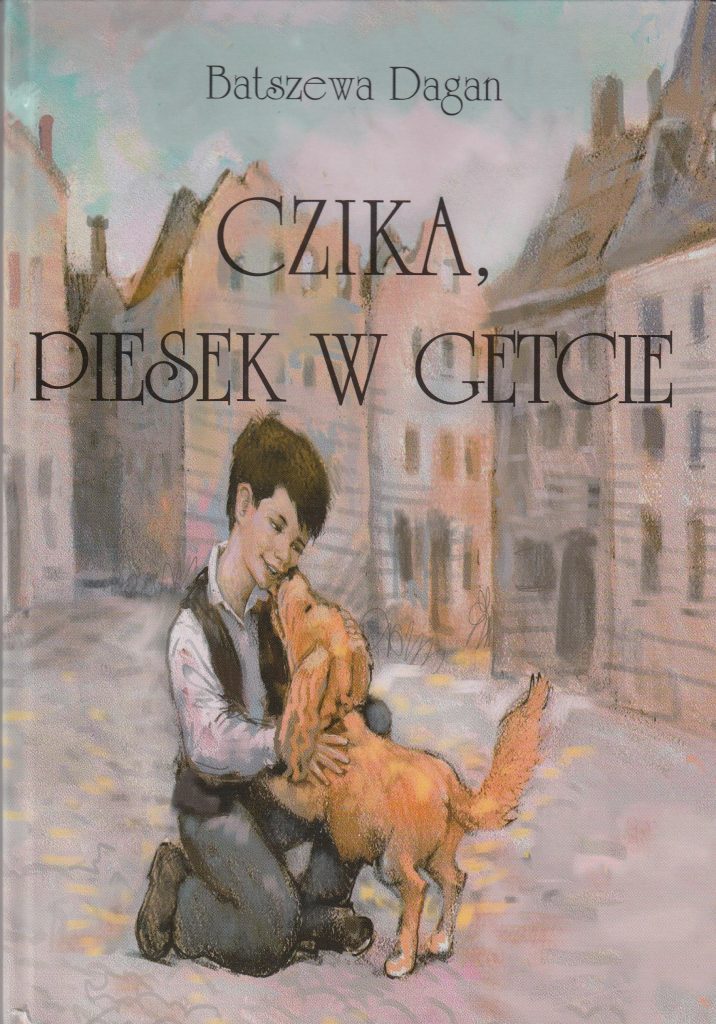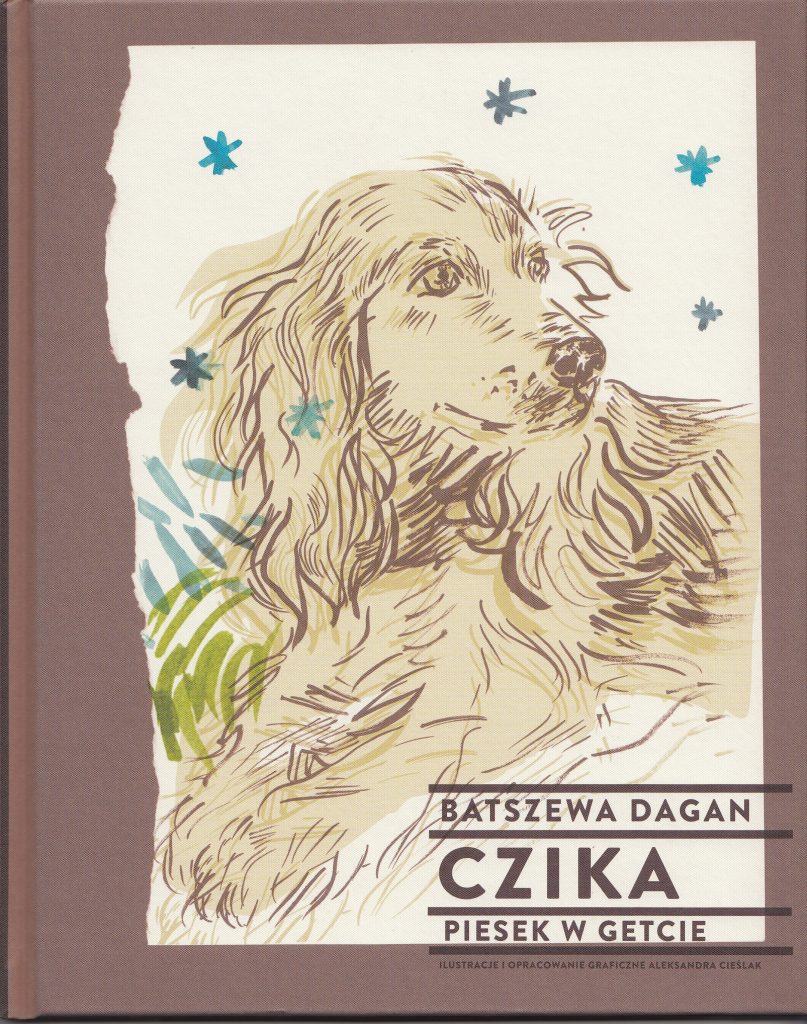Author: Bat-Sheva Dagan [בת שבע דגן]
Illustrator: Avi Katz
Translator: Szoszana Raczyńska
Year: 2012
Publisher: Państwowe Muzeum Auschwitz-Birkenau
Place of publicaion: Oświęcim
Pages: 32
ISBN: 9788377040362
Notes: Translation from Hebrew (1992). Second edition with illustrations and graphic design by Aleksandra Cieślak: B. Dagan, Czika, piesek w getcie, Oświęcim: Państwowe Muzeum Auschwitz-Birkenau, 2018, s. 40, ISBN: 9788377042632. The book was also adapted by Sandrę Schießl into short animated film (https://vimeo.com/270511276).
Translations:
- צ’יקה, הכלבה בגיטו, il. אבי כץ, Tel-Aviv: Maor, 1992, pp. 32;
- Chika, die Hündin im Ghetto, ill. Avi Katz, trans. N. Bareli, Frankfurt (Oder): Werbeagentur Medien und Verl. GmbH, 2008, pp. 32, ISBN: 9783981235814;
- Chika, la chienne dans le ghetto, ill. A. Cieślak, trans. N. Jagodnik, Oświęcim: Musée d’État d’Auschwitz-Birkenau, 2018, pp. 40, ISBN: 9788377042717;
- Chika, the Dog in the Ghetto, ill. Avi Katz, Cleveland, Ohio: Kay Tee, Inc., 1993, pp. 32;
- Cika, una cagnolina nel ghetto, ill. A. Cieślak, trans. S. Santoliquido, Oświęcim: Museo Statale di Auschwitz-Birkenau, 2018, pp. 40, ISBN: 9788377042700;
- Чика, собачка из Гетто, ill. Ави Кац, trans. А. Ротман, Иерусалим: Джойнт, 2000, pp. 31.

Cover by Avi Katz courtesy of the publisher. ©Państwowe Muzeum Auschwitz-Birkenau w Oświęcimiu, 2012 
Cover by Aleksandra Cieślak courtesy of the publisher. ©Państwowe Muzeum Auschwitz-Birkenau w Oświęcimiu, 2018
The main character of this story is five-year-old Michaś, who had to move to the ghetto with his family and their female dog Chika. One day, the Germans decide that the Jews must give up all of their dogs. Michaś cannot accept the order, so his parents find another solution: Czika is going to live with Ms. Hanusia, “a non-Jew who lives outside of the ghetto.” The protagonist’s father walks the dog out of the ghetto and to a country home of a woman who agrees to look after Chika despite her limited food supplies. When transports to concentration camps begin in the ghetto, Michaś’s family retreats to a hideout that they prepared earlier. They survive the war. When the Soviet army enters the city, the family is able to leave the hideout and welcome Chika again.
This short story presents the life of Jews in a ghetto which is depicted as small in size and not fenced-in. It focuses on the relationship between the boy and his pet. At the end of the book, a short glossary can be found (“ghetto,” “Nazi,” “concentration camp”). A CD is included with two lesson plans based on a book on tolerance, otherness, World War Two and the Holocaust.
Bibliography:
- Ippoldt, L., Dziecko a wojna – literatura dla dzieci o tematyce wojennej na wybranych przykładach polsko- i niemieckojęzycznych, „Orbis Linguarum”, no. 48, 2018, pp. 501–504 (p. 503);
- Jarzyna, A., Szlemiele. Zwierzęta wobec Zagłady w literaturze dla dzieci, „Narracje o Zagładzie”, no. 2, 2016, pp. 235–256;
- Jarzyna, A., Post-koiné. Studia o nieantropocentrycznych językach (poetyckich), Łódź 2019 (pp. 191–214);
- Jeziorkowska-Polakowska, A., „biała plamka na tle MURU to ja…” – angielski buldog opowiada o Zagładzie, [in:] (Nie)zapomniane zwierzęta, eds. E. Łoch, D. Piechota, A. Trześniewska-Nowak, Gdańsk 2021, pp. 129–161 (p. 132, fn. 6);
- Krupiński, P., Pies patrzy na getto. Zwierzę jako podmiot narracji postholokaustowych, [in:] Ślady II wojny światowej i Zagłady w najnowszej literaturze polskiej, eds. B. Sienkiewicz, S. Karolak, Poznań 2016, pp. 57–84;
- Mioduszewska, Z., Zwierzęta w literaturze o Zagładzie, [in:] Koziołek Matołek i inne bajkowe zwierzęta w tekstach literatury i kultury, eds. M. Bator, B. Gierszewska, K. Kępczyk, Pacanów 2016, pp. 44–55 (p. 54);
- Rybak, K., Obrazowanie Zagłady. Narracje holokaustowe w polskiej literaturze XXI wieku dla dzieci i młodzieży, Warszawa 2023 (s. 66);
- Sikora, A., W jaki sposób mówimy dzieciom o wojnie? Charakterystyka prozy o tematyce wojennej na podstawie wybranych książek dla dzieci, „Acta Universitatis Lodziensis. Folia Librorum”, no. 2 (19), 2014, pp. 25–44;
- Wójcik-Dudek, M., Konieczność śladu. Kanony literatury dla dzieci i młodzieży, „Narracje o Zagładzie”, no. 1, 2015, pp. 96–116 (p. 104);
- Wójcik-Dudek, M., W(y)czytać Zagładę. Praktyki postpamięci w polskiej literaturze XXI wieku dla dzieci i młodzieży, Katowice 2016 (pp. 32–33, 195);
- Вуйчик-Дудек, М., Животните и Холокостът в съвременни полски текстове за млади читатели, „Дзяло”, no. 17, 2020.